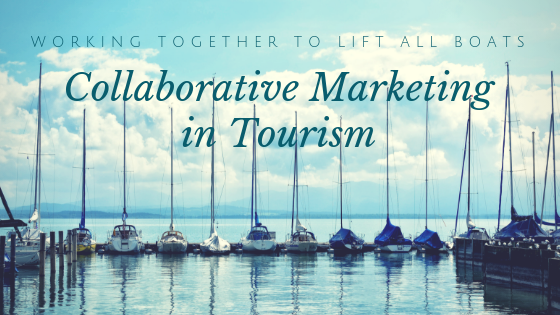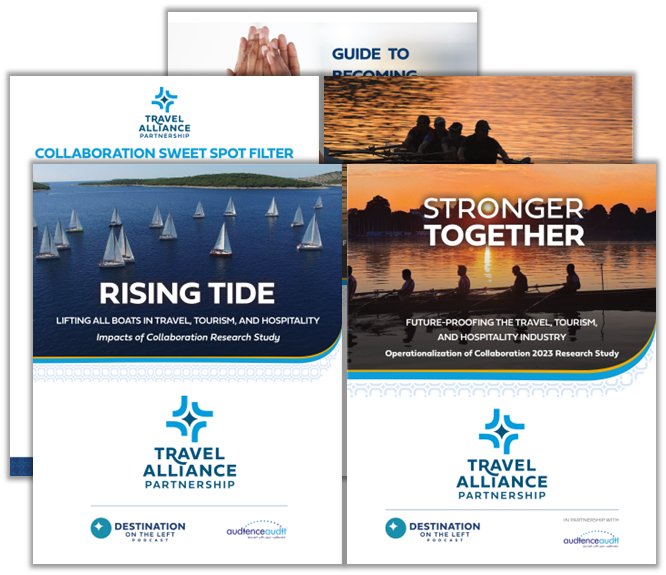Collaborative Marketing in Tourism: Working Together to Lift All Boats
In the travel, tourism and hospitality industry, we understand how difficult it can be to grab the attention – and reservation – of a visitor. With limited time and a set budget, travelers have the tough decision of choosing where to go. As a destination, you may often feel like you’re competing against other tourist destinations. In reality, a rising tide lifts all boats. Meaning that by working together with other destinations, you can increase visitation that impacts all of the area assets. Travelers need several things to do, places to eat and places to sleep during their trip. They aren’t going to visit the same attraction or eat at the same restaurant over many days. By working together with other businesses and tourism assets on collaborative marketing, you create a better experience for the visitor and encourage multiple overnights.

What is Collaborative Marketing?
Collaborative marketing means leveraging the resources of multiple partners to create successful marketing programs. We like to think of these programs as co-opetition. Partners cooperate with their perceived competitors to create a product that is larger than one they can execute on their own. Partners could include neighboring counties, different destinations or themed assets.
Let’s start with the benefits of working together.
- Bigger Budget. When partners pool their budgets together, you are able to do bigger and better things that are mutually beneficial. More money could mean building a new website, buying more digital advertising, printing additional collateral, or attending more shows.
- More Exposure. The more partners involved, the more people who are promoting your product. Each entity can talk about it on their social media channels, post it on their website, include it in their collateral or mention it during trade and media shows.
- Broader Appeal. Travelers are more likely to take a trip when there are multiple points of interests. Think: the more things there are to do, the more appealing the trip is. Travelers may be more interested in your destination when it’s packaged within a region, because there are more things to see and do. By adding more assets to your inventory, you’re providing a something-for-everyone approach. This is especially important when it comes to international tourism. FIT (what is FIT?) need to know there are enough assets to fill their time before booking a trip to another country.
How to implement collaborative marketing in tourism:
Trails string together multiple stops with a specific theme in an easy-to-travel way.
They do most of the work for visitors, allowing people to choose their beginning and end points. Trails are also very trendy because they encourage visitation to multiple stops. That means you’re more likely to attract visitors that wouldn’t necessarily make a one-off stop. Travelers want to feel a sense of accomplishment as they check off trail stops, especially if they receive a prize for completing the route. Wayne County’s Apple Tasting Tour – local farms, farm markets and wineries that showcase apple products during October – asks visitors to participate in a challenge to collect stamps or digital badges at each stop. Completed entries can be entered to win various prizes.
See how we helped Wayne County adapt the tour in 2020 to be digital and keep their gamification.
Regional DMOs act as the Destination Marketing Organization (DMO) for multiple destinations.
The organization administers marketing campaigns on behalf of the region, creating one shared voice and presence. Finger Lakes Regional Tourism Council (FLRTC) represents the 14 Official County TPAs in the Finger Lakes Region and Regional Office of Sustainable Tourism /Lake Placid CVB (ROOST) represents Lake Placid, Essex County, Franklin County and Hamilton County. For example, the FLRTC PR program is one of the ways it successfully promotes the region as a whole.
Products and Programs identify a specific initiative or target an identified market.
For example, the Go North program includes partners from part of the New York State capital region, Saratoga, Queensbury, the Lake George region and through the Adirondacks. It is an effort to attract international travel trade through an itinerary they use when speaking to that market. As Hilarie Logan-Dechene from the Wild Center explains in episode 52 of Destination on the Left, “It’s going to help everybody, and that’s the kind of sea change in thinking that we’ve gone through over the last 20 years or so. This is not a little trite statement, but if we can work together, we’ll all succeed.”
In many instances, a product or program is first created and the tactics follow.
- Itineraries outline a suggested route or order to visit recommended stops. Some itineraries take visitors to the must-see assets in a specific region, while others speak to a theme such as family-friendly or history and arts. They help travelers envision what their visit may look like – whether that’s across a county, region or even a state. Rhonda provides some great examples of collaborative itineraries as well as tips for creating your own FIT itinerary.
- Collateral visually explains collaborative programs or highlights activities in a region. Guides can be downloaded off websites, distributed via welcome centers or passed out at shows. Fresh Air Adventures‘ brochure colorfully showcases the fun and thrilling things to do across the communities of Genesee, Wyoming, Livingston & Orleans Counties.
- Trade Shows introduce collaborative marketing programs to specific audiences, such as international groups. These programs can also benefit from attending media shows. For example, the Haunted History Trail meets journalists, bloggers and influencers interested in learning about the spooky history of New York State attractions.
- Media Buys put a product or region in front of an audience via traditional or digital advertising. Collaborative media buys are more affordable because each partner contributes to the overall cost of the buy.
Author
Related Posts
How Curated Experiences Can Help Your Tourism Marketing
In years past, travelers may have been satisfied to see sites like the Eiffel Tower or Colosseum; now they want to get behind the scenes,...
Marketing for Group Travel: Building Solid Relationships with Tour Operators
Group travel is a significant segment of the tourism market, and if you want to see those buses pulling up to the curb and filling…
